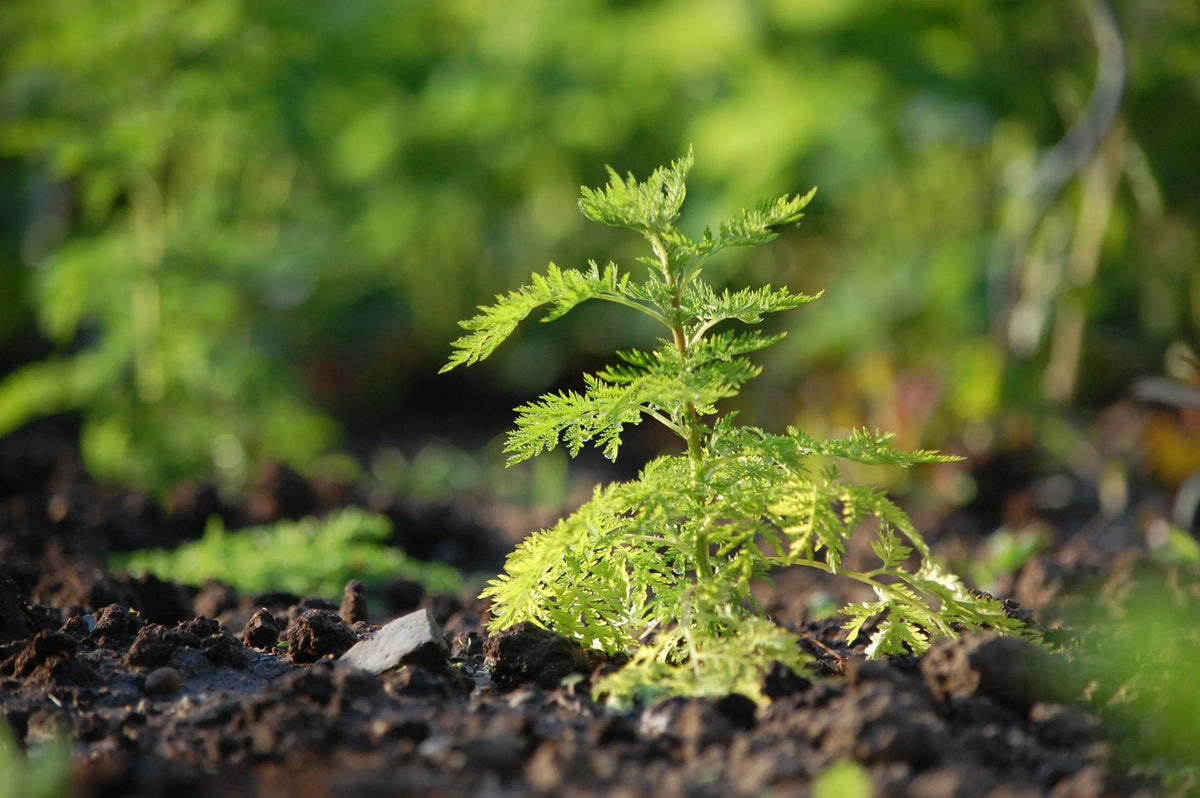

The decisive difference: The wild forms of Artemisia annua (A-2) vs. our cultivar Artemisia annua anamed (A-3)
Contents
Bereits 1986 dachten Mitarbeiter des Vereins “anamed” darüber nach, den einjährigen Beifuß zu verbreiten. Denn schon damals erkannten sie das großartige Potenzial dieser einzigartigen Pflanze und sahen sich in der Mission, das preiswerte Gewächs für mehr Menschen zugänglich zu machen.
Die ambitionierten Vereinsmitglieder bemerkten jedoch schnell, dass ihr Vorhaben mit einer entscheidenden Herausforderung einherging: Es gibt keine definierte, einheitliche Art der Artemisia annua. Stattdessen besteht die Pflanze aus unzähligen Unterarten, die von Land zu Land sehr verschieden sind. So variieren die zahlreichen Wildformen in Zusammensetzung und Gehalt ihrer über 600 Inhaltsstoffe und auch die Trocknung wird je nach Region und je nach Tradition unterschiedlich gehandhabt. Hinzu kommt, dass die Verwendung der Pflanzenteile nicht gleichbleibend ist: Während in manchen Ländern Blätter, Stängel und Blüten zum Einsatz kommen, nutzt man in anderen Regionen die Blätter mit oder ohne Stängel oder Blätter mit oder ohne Blüten, teilweise zermahlen, teilweise nicht zermahlen - doch alle Produkte werden gleichermaßen mit “Artemisia annua” beschriftet und als solche verkauft.
To solve these problems, anamed began working with scientists from various countries in 1996 to offer a standardized, reliable Artemisia annua product . They researched and created a new subspecies, which they named Artemisia annua anamed (A-3) and soon made available to everyone worldwide.

Today, A-3 breeding is even used for studies by leading researchers such as Prof. Pamela Weathers and is recommended in good conscience by recognized experts such as Prof. Dr. Max Moser and Dr. Sarah Moritz.
The direct comparison
Artemisia annua wild forms (A-2)
The wild forms of Artemisia annua have a number of disadvantages. On the one hand, they usually only reach a height of 50-100 centimetres and offer a low yield of leaves, which also contain an uneven number of ingredients . The artemisinin content is also relatively low and varies between 0.05 and 0.4%. In addition, Artemisia annua is an allergenic early-flowering plant , which can lead to challenges in the form of respiratory problems, especially for allergy sufferers who want to cultivate the plant in their own garden or let it run wild.
Artemisia annua anamed (A-3)
The advantages of our special variety A-3 are numerous. The most important is probably its remarkable artemisinin content, which is an impressive 1.4% - around 20 times the content of many wild forms. But it is not only its artemisinin content that is significantly higher - its growth height can also reach a remarkable 3 meters and it enjoys a high yield of its valuable leaves. Artemisia annua anamed is also a very allergy-friendly variety, as it does not start flowering in Europe until late fall or winter if grown correctly and is then harvested as soon as buds appear.
At this point we would like to emphasize that our unique special variety Artemisia annua anamed is a completely pure, natural plant form that is based exclusively on traditional plant breeding - without any genetic modifications.

What does A-3 stand for?
A-3 is based on a whole series of values with which we identify. These include
- Social projects: We primarily support small farms in remote regions
- Ecological and sustainable: The products we sell are free from any harmful substances and pesticides. This fact is regularly tested by an independent German laboratory.
- Politisches Engagement: Im Kampf gegen die EU-Lobby setzten wir uns standhaft dafür ein, Artemisia annua Produkte weiterhin für alle Menschen zugänglich machen zu dürfen. Dafür haben wir vor Gericht schon mehrere Prozesse angestrengt und über 70.000 Euro ausgegeben, um die Freiheit solcher Pflanzen weltweit zu garantieren.
- Advocacy: We stand for fairness and equal opportunities. That is why we also want to give financially disadvantaged people around the world access to Artemisia annua products.
- Transparency: Transparent production: Through on-site seminars open to the public, you can see teemana's cultivation and production conditions for yourself.
- Networking: We maintain close contact with scientists from all over the world in order to constantly guarantee the highest quality according to the latest scientific findings. Even leading researchers and experts such as Prof. Pamela Weathers and Prof. Dr. Max Moser are convinced by our A-3 cultivation.
What should I look out for when buying Artemisia annua products?
Green color
An important indication of flawless Artemisia annua quality is a vibrant, bright green color of the product. A brown/yellow discoloration of the leaves or even a mild green indicates a lack of ingredients in the leaves in question. Only under optimal light and water conditions do the leaves achieve their bright green color and full content of ingredients. For this reason, yellow and brown leaves should be sorted out after harvesting so that they do not end up in the end product. Dirt can also cause the Artemisia annua product to lose its intense color. However, dirt is almost unavoidable in a mechanical harvesting process. At teemana, however, we have always relied on manual harvesting by hand.
Also pay attention to the scent that the dried Artemisia annua leaves give off. An aromatic scent is characteristic of high-quality products, while a mild or completely absent scent is a sign of inadequate quality.
Pure leaf cut
Another important sign that indicates high-quality Artemisia annua is a pure leaf cut or powder without stems, flowers or other plant parts. Unfortunately, however, many commercially available products contain quite a lot of stems and branches in addition to the leaves - in the case of the usual Herba quality, this is often up to 80%. It is important to know that only the leaves of the Artemisia annua plant are characterized by a high content of ingredients , while the stems contain little to no ingredients.
Regional cultivation
In addition to the visual characteristics, you should also pay attention to the regional cultivation of your Artemisia products. This is because quality standards vary greatly from country to country and in many countries, Artemisia plants are cultivated using harmful pesticides and fertilizers. In dictatorial countries, farmers are sometimes even forbidden to have the soil tested for harmful substances before growing Artemisia. However, contaminated soil leads to a contaminated product. However, our Artemisia annua anamed can be recommended without hesitation, as it is regularly microbiologically tested by an independent German testing laboratory and checked for quality, harmful substances and heavy metals before being released.
Quality has its price
Ensuring Artemisia annua products meet high quality standards requires a great deal of effort. This is because it is necessary to carry out processes such as sowing, caring for and harvesting the plants by hand in order to meet the conditions mentioned. Gentle drying and sorting out unwanted stems and leaves is also largely done manually and takes a lot of energy and time. It is therefore hardly surprising that the price of high-quality products is adjusted accordingly and that comparatively cheap products cannot possibly meet the same quality standards.
For example: a field worker in Germany earns about 100 times as much as a picker in north-east India. For the price we pay our German farmers for 1 kilo of A-3 production, we would get 150 kilos of (brown) A-2 (i.e. wild) produce from Asia.
If you extrapolate these facts, the higher-quality offer is definitely worth it:
|
Type
|
Price per 100g
|
Artemisinin content in the leaves
|
Price per 1 mg artemisinin
|
Conclusion
|
|
Wild form (A-2) pure leaves
|
29,70€
|
0,1%
|
29 cents
|
More expensive
|
|
Wild form (A-2) with stems
|
18,99€
|
0,1%
|
180 cents
|
More expensive
|
|
Artemisia annua anamed (A-3) pure leaves
|
46,00€
|
1,4%
|
3 cents
|
Cheaper
|

Left: A common wild form with stems; Right: A-3 leaf section
Conclusion
Since the research and distribution of Artemisia annua anamed (A-3) in the 1990s, this unique strain has enjoyed widespread popularity and popularity. Not without reason, as it is a species with countless benefits and a consistent, reliable artemisinin content.
So when we refer to our product as "the original", we are referring to the fact that it has proven itself on the market for years and enjoys a high level of recognition and attention. Certainly, many wild forms of Artemisia annua have been cultivated and used for over 2000 years - but our exquisite breeding has marked a major breakthrough that promises everyone a uniform, consistent quality of Artemisia annua products.
Have you become curious?
Then convince yourself of the outstanding standards of our Artemisia annua anamed products and benefit from the countless advantages of this green masterpiece of nature!



